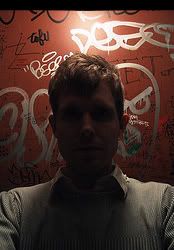Armourer Norman Finkelshteyn Aims For the Kishkes
 Norman Finkelshteyn wears many hats, but one of those hats is a steel-plated battle helmet. I interviewed this armor craftsman about his favorite scary movies back in January, but our conversation is worth revisiting in its entirety-- even if it's been a while since you jousted.
Norman Finkelshteyn wears many hats, but one of those hats is a steel-plated battle helmet. I interviewed this armor craftsman about his favorite scary movies back in January, but our conversation is worth revisiting in its entirety-- even if it's been a while since you jousted.
TB: Who exactly buys armor nowadays?
NF: Reenactors-- people who play at history (like the Civil War stuff but medieval and ancient). There are a number of groups, from some who are really serious about authenticity, to those more like a frat party in costume. Many of them use this armour in actual combat, either as performances or as competitive sports.
There is also a sort of minor development of people (separate from the reenactors) doing Western Martial Arts, like swordsmanship and jousting. The horse jousters have even got professional competitions with sponsors and ESPN coverage.
Also, people who think it would just "look cool" in the living room...
TB: What's the most complicated piece of armor you've made?
NF: The Dalton School wanted a helmet for a fake Mongol burial that they have their fifth graders excavate. Getting really educational, I tried to involve as many features of Mongol helmet design as could plausibly fit into the one example. Some bits involved really intricate steel bending-- like three opposing directions at once. Then you go from steel hammering to fine sewing on soft leather. But that may vie for design intricacy with a Russian breastplate I made: the steelwork was quite simple but the whole thing was held together and moved on hidden leather straps so the trick was visualizing the whole thing in every aspect of movement as you try to design the separate pieces, then match up just the right bits of leather and decide where to put the attachment points (all with a client out in Texas who I've never actually seen - he just sent me measurements).
Of course, in reality, the toughest pieces are little detail bits that people barely notice-- the brass ear guard on a Roman helmet I did as an aprentice, a little bracket on an otherwise simple helmet... things like that.NF: I came to a Renaissance Faire and asked an armourer there to aprentice. He was one of a few craftsmen who actualy demonstrate their work rather than just sell stuff. I aprenticed for him at that faire for a number of years.
TB: How did you get your start?NF: Write, draw comics, write computer programs. Mostly I'm a lawyer nowadays. Right now in fact, I'm awaiting with baited breath whether the Supreme Court will grant my petition and hear what I think is a major Civil Rights case that could revolutionise the American publishing industry. Here are the starting papers on that case.
TB: What else do you do for a living?
TB: Why do you love horror movies or think they're important?
NF: Tricky question, that! For me, horror is escapist fantasy. Is it important? Some would say no, they want realism. But screw that-- I got enough realism at home! That's actually why I don't like slasher horror-- I want the full-blown fantasy, not something off the yellow journalism sheets.
It all depends on what you mean by "horror". The best ones tap into and explore the darkest recesses on our mind. Not just the human mind, but the kishkes, the primal lizard mind hiding in our stomach. But then, I suppose the "horror porn" does the same thing but in salacious/ icky way. There is only so deep you want to go-- that's why Freud considered repression to be a good thing!
I really apreciate the classy/fantasy stuff, the religious mythological pretentions of raising eldrich ancient gods in something like Hellboy or Constatine (though I thoroughly disagreed about the movie reworking of that one). Of course, getting to the roots of it - I love the 19th century Gothic fantasyand really get into the reworkings of it in the movies. And then there's the pre-WWII pulp like Lovecraft and Robert E Howard (Conan). After reading enough Lovecraft, you find that most of modern horror are really copies of stuff he did-- from primal horrors under the seas to the inbred hick imagery of Deliverance.










No comments:
Post a Comment